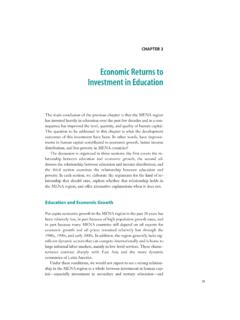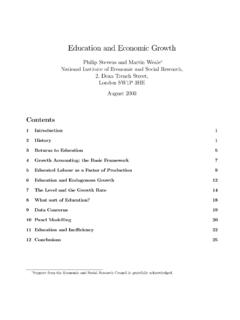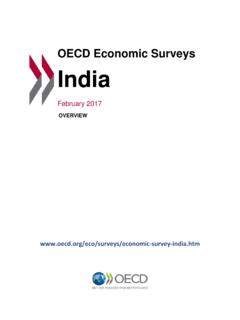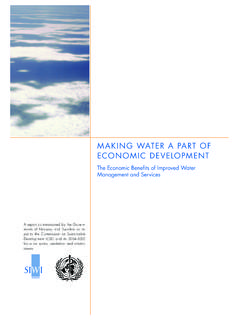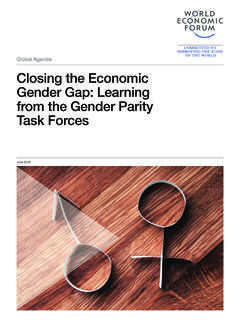Transcription of Returns to Investment in Education: A Further Update
1 education Economics, Vol. 12, No. 2, August 2004 ISSN 0964 5292 Print; 1469 5782 Online/04/020111 24 2004 Taylor & Francis LtdDOI: to Investment in education : A Further UpdateGEORGE PSACHAROPOULOS & HARRY ANTHONY PATRINOS*Taylor and Francis Economics0964-5292 (print)/1469-8257 (online)Original Article2004 Taylor & Francis Ltd122000000 August 2004 GeorgePsacharopoulosKasou 5,Athens to Investment in education based on human capital theory have beenestimated since the late 1950s. In the 40-plus year history of estimates of Returns to invest-ment in education , there have been several reviews of the empirical results in attempts toestablish patterns.
2 Many more estimates from a wide variety of countries, including over-time evidence, and estimates based on new econometric techniques, reaffirm the importanceof human capital theory. This paper reviews and presents the latest estimates and patternsas found in the literature at the turn of the century. However, because the availability ofrate of return estimates has grown exponentially, we include a new section on the need forselectivity in comparing Returns to Investment in education and establishing related to Investment in education , in the modern/human capital sense of the term,have been estimated since the late 1950s.
3 In the 40-plus year history of estimates ofreturns to Investment in education , there have been several reviews of the empiricalresults in attempts to establish patterns (see Psacharopoulos, 1973, 1985, 1994).The rise in earnings inequality experienced during the 1980s and 1990s in manycountries led to renewed interest in estimates of Returns to schooling (see, for exam-ple, Murphy & Welch, 1992). A very large literature suggests that systematicchanges in the production process led to changes in the demand for certain types oflabor. It was argued much earlier in the literature that education is more productivethe more volatile the state of technology (Nelson & Phelps, 1966; Griliches, 1969;Welch 1970; Schultz, 1975).
4 A more selective rates of return estimate review focusing on the causality debatebetween schooling and earnings (Card, 2001) reaffirms Griliches (1970) conclusionthat the effect of ability and related factors does not exceed 10% of the estimatedschooling coefficient. Instrumental variable (IV) estimates of the Returns to educa-tion based on family background are higher than classic Ordinary Least Squares esti-mates based on the early work of Mincer, Becker and Chiswick (Becker & Chiswick,1966; Mincer, 1974). The estimation method makes little difference on the returnsto education . The IV estimates are often higher than Ordinary Least SquaresG.
5 Psacharopoulos, University of Athens, Kasou 5, Athens 11364, Greece. E- mail: Patrinos, World Bank, 1818 H Street, NW, Washington DC, 20433, USA. E-mail: Psacharopoulos & H. A. Patrinosestimates, although it is unclear to what extend this is due to measurement error orinadequate instrumentation (see Trostel et al., 2002).In this paper, we begin by following the tradition and present latest estimates andpatterns. However, because the availability of rate of return estimates has grownexponentially, we include a new section on the need for selectivity in comparingreturns to Investment in education and establishing related Latest PatternsThe classic pattern of falling Returns to education by level of economic developmentand level of education are maintained (see Tables 1 and 2 and Figures 1 4).
6 Also,in the updated data set the private Returns to higher education are increasing. Thesenew results are based on six new observations and updated estimates for 23 coun-tries since the last review (Psacharopoulos, 1994). Estimates of the raw Returns toeducation for 98 countries are presented in Appendix A, Tables A1 A4. These esti-mates cut along policy issues in the literature. An effort has been made to select ratesof return as comparable as possible (but see the section next). Returns to Investment in education by level, latest Returns and mean years of Returns to Investment in education by income Returns to Investment in education by Returns are higher than social Returns , where the latter is defined on thebasis of private benefits but total (private plus external) costs (Figure 1).
7 This isbecause of the public subsidization of education and the fact that typical social rateof return estimates are not able to include social benefits. Nevertheless, the degreeof public subsidization increases with the level of education , which has regressiveincome distribution , the average rate of return to another year of schooling is 10%. Returnsto education by level of country income are presented in Table 3 (and Figure 4).The highest Returns are recorded for low-income and middle-income Update includes new country estimates and updated estimates for 42 Returns to schooling are highest in the Latin America and the Caribbeanregion and for the sub-Saharan Africa region (Table 4).
8 Returns to schooling forAsia are at about the world average. The Returns are lower in the high-income coun-tries of the OECD. Interestingly, average Returns to schooling are lowest for the non-OECD European, Middle East and North African group of 1. Returns to Investment in education by level, latest to Investment in Education113 During the past 12 years, average Returns to schooling have declined by points (see Appendix A, Table A4). At the same time, average schoolinglevels have increased. Therefore, and according to theory, everything else being thesame, an increase in the supply of education has led to a slight decrease in thereturns to , women receive higher Returns to their schooling investments (Table 5and Figure 5).
9 But the Returns to primary education are much higher for men (20%)than for women (13%). Women, however, experience higher Returns to secondaryeducation (18% versus 14%).Mincerian Returns to education by More Selective ApproachReturns to education compilations, as already presented, have been attacked in theliterature (see Bennell, 1996), although not for the right reasons (see Psacharopoulos,Fig 2. Mincerian Returns and mean years of 3. Social Returns to Investment in education by income Psacharopoulos & H. A. Patrinos1996). The real reason one should be skeptical about indiscriminate rate of returncompilations, and in spite of the efforts of the compilers, is that in the original worksthe estimates are rarely fully comparable.
10 There are two main sources of non-compa-rability: data sample coverage and , a rate of return to Investment in education should be based on a repre-sentative sample of the country s population. But in reality this is the exceptionrather than the rule. This is problematic when the estimated rates of return are basedon a survey of firms rather than households because firm-based samples arehighly selective. In order to control survey costs, such samples focus on large firmswith many employees. Second, the questionnaire is typically filled by the payrolldepartment rather than by the individual employee.










